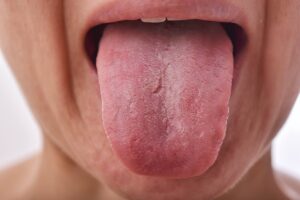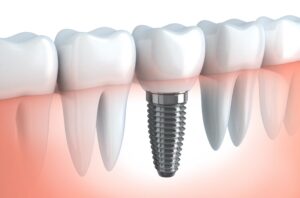Header logo
header top contact widget
Systemic Inflammation
Beware of Hidden Contributors to Gum Disease, Tooth Loss
Posted on Aug 19, 2023 by William J. Claiborne, DDS MS
Decades ago, oral health was something many people took lightly, often waiting until something hurt to see a dentist. The fierce pain of a cavity or abscess or the sharp jolt of something hot or cold on an area of gum recession were motivators to for a dental visit.
However, Americans are now realizing how very important their oral health is in how it relates to overall health.
The correlation lies with bacteria that live within the gum tissues. While all mouths contain “good” and “bad” bacteria, research has determined that the bad type can cause problems within and outside of the mouth.
The bad bacteria are inflammatory. An accumulation of these inflammatory bacteria are what lead to periodontal (gum) disease. Gum disease is the nation’s leading cause of adult tooth loss. Additionally, advanced periodontal disease – periodontitis – can trigger or even worsen serious health condition far beyond the mouth.
Although gum disease can begin without any obvious symptoms, once it exists, progression occurs in three stages, which are:
• Gingivitis – As the initial stage of gum disease, inflammation is triggered by plaque buildup at the gum line. When daily brushing and flossing fail to thoroughly remove plaque, toxins form that cause irritation to the gum tissues. Once signs emerge, they may include seeing blood in the sink when brushing or having sore, swollen gums. At this stage, however, damage may be reversed with prompt response.
• Periodontitis – As the disease advances, the bone structures and fibers that support teeth are damaged by the destruction of infectious oral bacteria. At this stage, inflamed gums form pockets below the gum line, filling with bacteria-laden plaque.
• Advanced Periodontitis – In the advanced stage of gum disease, fibers and bone supporting natural teeth are destroyed. This can cause teeth to shift or loosen, requiring aggressive treatment to prevent tooth loss. Eventually, some teeth may require removal.
As devastating as tooth loss can be to one’s overall health, the bacteria of gum disease can enter the bloodstream. Research has shown this infectious bacteria can trigger inflammatory reactions elsewhere in the body, correlating to heart disease, stroke, high blood pressure, some cancers (including lung and pancreatic), diabetes, arthritis, impotency, preterm babies, Alzheimer’s disease and more.
Obviously, people should be highly-committed to the care of their oral health. Yet, statistics in America along these lines are not impressive. The Center for Disease Control’s Division of Oral Health cites that 1 out of every 2 American adults 30 and over has periodontal disease. They also shared that periodontal disease is higher in men than women (56.4% vs. 38.4%) with high prevalence rates among smokers (64.2%) and adults 65+ (70.1%).
In addition to your twice-a-year dental check-ups and cleanings, there are other ways to support oral wellness between visits. One is in keeping the mouth moist, supporting sufficient saliva flow.
When saliva flow is insufficient, bacteria are able to accumulate and multiply rapidly. In addition to oral dryness as a part of the aging process, contributors can be consuming alcoholic beverages, caffeine, and as a side effect of many medications (both OTC and Rx).
One reason to keep your dental professionals aware of ALL the medications your take is in how they can interact with certain procedures, including numbing agents. For example, medications to reduce blood clotting, which lowers your risk for stroke and heart disease, can cause bleeding problems during oral surgery or periodontal treatment.
For those who take medications that help to strengthen bones, these have been associated with a rare but serious condition called osteonecrosis of the jaw. Simply put, it refers to death of the bone. The risk of these prescriptions is greater for those administered by injection or intravenously.
Osteonecrosis of the jaw commonly occurs after dental procedures (tooth extraction, implant placement). Over 90% of those who have experienced osteonecrosis are those who have taken the medication in repeated high doses due to cancer or other diseases.
However, 10% who experienced osteonecrosis were taking much lower doses, mostly intended to treat osteoporosis.
Certain medications also affect the ability to taste, including cardiovascular agents, central nervous system stimulants, non-steroidal anti-inflammatory drugs, respiratory inhalants and nicotine skin patches.
Some medications can also cause the development of oral sores, inflammation or discoloration of gum tissues in the mouth. These oral sores or discolorations may arise from taking medications for blood pressure, oral contraceptives and chemotherapy agents.
Dry mouth is a common side effect of a wide variety of medications, including prescriptive and over-the-counter. These include antihistamines, decongestants, painkillers, high blood pressure medications, muscle relaxants, drugs for urinary incontinence, anti-depressants and many others. Drying causes the soft tissues in the mouth to become inflamed and makes you more susceptible to infection. When saliva flow is depleted, your risk for tooth decay and gum disease increases.
Supplements that may seem unconnected to your oral health can actually effect your care more than you realize. It is important for your dentist to know if you take…
• Ginkgo biloba or evening primrose – These herbs can reduce your blood’s ability to clot, possibly leading to excessive bleeding during and/or after a dental procedure.
• St. John’s Wort – This herb, which is often taken to reduce anxiety, can interfere with the metabolism of other medications, including sedatives, antibiotics and anti-inflammatory drugs such as prednisone and Decadron. When combined with St. John’s Wort, these drugs can be less effective. On the other hand, narcotics such as codeine, Vicodin and oxycodone can become more potent when taken with St. John’s Wort. This can lead to sleepiness, lethargy and dizziness.
• Valerian – This herb has mild sedative effects. If your dentist prescribes drugs for anxiety or painkillers containing codeine, the effects of both together are greatly accentuated. This can lead to severe sleepiness, lethargy and dizziness that can last into the next day.
• Calcium and magnesium – When these supplements are combined with certain antibiotics, they can decrease the antibiotics being properly absorbed. This can compromise your ability to fight off infection.
As a periodontal specialist, I find that most cases of dry mouth are due to factors that can be easily controlled with simple changes. If you have delayed or avoided dental care, call 828-274-9440 to request a consultation, or begin with a thorough examination in our Asheville periodontal office.
And, if you are experiencing signs of gum disease, please know this disease will only worsen without treatment. The sooner you have treatment, the less involvement your treatment will likely be.
We offer the latest techniques, technology, and skills while always making patient comfort a top priority. If dental fear or anxiety are concerns, please make us aware of this when you call or at your initial appointment. In addition to our standard comfort features, we offer Oral and I.V. sedation (“twilight sleep”).
How the “Bad” Bacteria in the Mouth Can Lead To Serious Health Problems
Posted on Aug 08, 2023 by William J. Claiborne, DDS MS
The human body is a fascinating structure. It seems every year there are new findings that show just how complex and amazing it is.
 Recently, one of the biggest areas of interest has been the study of microbiome in the body. Once thought to be icky little cesspools, these colonies of microorganisms are now seen as having an important role in our health. For example, the microbiome in the gut has been shown to aid in digestion and it’s now seen that skin microbiome may potentially help people overcome conditions like acne and eczema.
Recently, one of the biggest areas of interest has been the study of microbiome in the body. Once thought to be icky little cesspools, these colonies of microorganisms are now seen as having an important role in our health. For example, the microbiome in the gut has been shown to aid in digestion and it’s now seen that skin microbiome may potentially help people overcome conditions like acne and eczema.
As a periodontist, I’ve followed research in how microbiome is being recognized for having a positive role in oral health. While bacteria that convert sugar to acid are the driving force behind tooth decay, this means that those critters in our mouths are not always bad guys.
There are about 700 different species of bacteria in your mouth. Some can be “bad,” yet the good bacteria are able to give our overall health a “leg up” in certain regards.
Certainly, having a clean, healthy mouth helps to prevent cavities and periodontal (gum) disease. However, read on to learn how the health of your mouth can contribute to your overall health to a rather significant extent.
Over the years, numerous studies have been able to pinpoint how diseases – such as heart disease, diabetes, arthritis, and more – might be triggered. The “trigger” seems to consistently link back to internal inflammation.
Inflammation in the body has been shown to set actions into play that cause the onset or worsening of a wide variety of health problems. Periodontal (gum) disease is a chronic inflammatory disease. This means the bacteria attacking gum tissues are in a consistently active state.
When the bacteria of gum disease enter the bloodstream (through tears in weakened gum tissues), it can create inflammatory triggers far beyond the mouth. This bloodborne inflammation, in turn, results in higher risks for heart disease, stroke, diabetes, preterm babies, arthritis, respiratory diseases and even impotency.
How can this occur?
In chronic inflammation, the body’s defense mechanism becomes stuck in the ‘on’ position. This sets off a chain of reactions that alter the helpful response of the immune to a harmful one. When an area in the body stays in an inflammatory setting, damaging reactions can occur.
Once in the bloodstream, several species of harmful gum disease bacteria can add to existing inflammation, including that in the arteries, where it can lead to heart attack and stroke.
In one study of 265 stroke patients, researchers found that patients with gum disease had twice as many strokes (due to thickening and hardening of brain arteries) as patients without. Additionally, patients with gum disease were three times as likely to have a stroke involving blood vessels in the back of the brain, which controls vision, coordination and other functions.
In a separate study of over 1,100 patients who had not experienced a stroke, researchers noted that 10% had severely blocked brain arteries. They also found that patients with gum inflammation were twice as likely to have moderately severe narrowing of brain arteries.
Another example is in the similarities between tissues of gum disease and those taken from arthritic joints. Studies show that gum disease is not only a risk factor for arthritis (both are inflammatory diseases), one can contribute to the other. Thus, gum disease is a risk factor for developing RA and arthritic patients have a greater risk for gum disease.
Additionally, people with diabetes are more likely to have periodontal disease than people without it, likely because they’re more susceptible to contracting infections overall, according to the American Academy of Periodontology.
Studies also show that pregnant women with periodontal disease have a greater risk of having pre-term and low birth weight babies. These indications have been found in amniotic fluid and in fetal cord blood samples of infants.
Findings show, too, that the bacteria of periodontal disease may contribute to a higher risk of pancreatic cancer. For years, researchers at the National Cancer Institute and the American Cancer Society have conducted cancer prevention and screening studies.
By studying oral samples, notably higher levels of two types of oral bacteria were measured in study participants with pancreatic cancer. One oral bacteria was found to create a 50% increased risk for pancreatic cancer and the second oral bacteria led to a 59% greater likelihood.
Chronic inflammation, in any area of the body, is a health risk that poses severe health challenges now highly recognized in the medical field. Not surprisingly, we occasionally see patients who have been advised by their surgeons to have their gum health checked prior to surgery. This proactive measure is to reduce risk factors that could complicate surgical outcome.
Your body’s natural defenses along with good oral hygiene — such as daily brushing and flossing — helps to keep bacteria under control. Also, people should readily recognize the signs and symptoms of periodontal disease.
Healthy gums fit snugly around the base of teeth and be a light pink color. Although the initial stage of gum disease (gingivitis) may exist without obvious symptoms, common signs of gum disease include:
• Swollen or puffy gums
• Bright red or purplish gums
• Gums that feel tender or bleed easily
• Spitting out blood when brushing or flossing
• Frequent or persistent bad breath
• Pus pockets between some teeth and gums
• Loose teeth or a change in the way teeth fit
• Painful chewing
• Gums that pull away from teeth or are sensitive to heat and/or cold
Maintaining good at-home oral hygiene is easy and takes just minutes a day. Brush twice a day (two minutes each time) and floss daily. Drink plenty of plain water throughout the day and limit sugar. Have dental cleanings every six months and follow your dental hygienist’s recommendations to keep oral bacteria at minimal levels between visits.
If you suspect you have gum disease or have delayed (or avoided) having regular dental care, call our Asheville periodontal dental office to schedule an examination. Or, ask to begin with a consultation appointment. During this time, we can discuss any concerns and I’ll answer your questions. Call 828-274-9440.
Let’s help you achieve a healthy, confident smile that adds to the well-being of your overall health!
Sources:
https://www.jnj.com/innovation/4-things-scientists-know-about-the-bacteria-in-your-mouth
https://www.nih.gov/news-events/nih-research-matters/identifying-new-contributor-tooth-decay
https://pubmed.ncbi.nlm.nih.gov/26474422/
http://www.health.harvard.edu/press_releases/heart-disease-oral-health
https://www.cancer.org/research/cancer-facts-statistics.html
Safe Tips for Cancer Patients To Protect Oral Health During Treatment
Posted on Jun 09, 2023 by William J. Claiborne, DDS MS
Cancer has touched so many in the U.S. It is a major, if not deadly, challenge for not just the cancer patient. The each individual diagnosed, it can also impact the lives of spouses, children, family members, and friends.
The progress in improving the rates of cancer survival in America are, fortunately moving in the right direction. As of January 2022, the National Cancer Institute shares that there are an estimated 18.1 million cancer survivors in the United States, representing approximately 5.4% of the population.
By 2032, the number of cancer survivors is projected to increase by 24.4% and by 2040, it is projected to grow to 26.0 million.
As progress continues, treatment for cancer remains a daunting ordeal. The long treatment time and extreme side effects associated with cancer treatment is seen as simply awful. The oncology teams that surround these patients are amazing, however, and try to lessen the burden throughout.
As a periodontist, I am familiar with the oral side effects of chemotherapy and radiation. I am very dedicated to these patients, and strive to help them be comfortable while protecting their oral health.
What’s important is to care for oral health in a way that keeps the patient comfortable while helping them to avoid any after-effects. This is where I differ with some advice for cancer patients since not all “tips” are good for the teeth and gums. For example, cancer patients undergoing chemotherapy may be advised to suck on on peppermint or lemon drops to relieve dry mouth. Not so fast…
Caring for oral health during any health condition that lowers the immune system can actually support your immune system by lowering systemic inflammation. Research has linked many health problems, including some cancers, to the bacteria of advanced gum disease (periodontitis).
Information shared by the American Academy of Periodontology states:
“Researchers found that men with gum disease were 49% more likely to develop kidney cancer, 54% more likely to develop pancreatic cancer, and 30% more likely to develop blood cancers.”
Oral dryness causes the tissues in the mouth to become inflamed, which places you at greater risk for infection. Insufficient saliva flow ups your risk for tooth decay and gum disease. So, it’s understandable that sucking on candy may help. However, the sugar from this candy that lingers in the mouth for long periods creates a higher risk of gum disease and the demineralization of tooth surfaces, opening the door for cavities.
One article in RDH Magazine shares these cautions for cancer patients:
• Products with drying and potentially irritating ingredients, like sodium lauryl sulfate, can increase risks for oral mucositis (the soft tissues in the mouth).
• Strong flavors can feel too sharp for tender tissue and can increase nausea.
• Inappropriate selection of toothbrush head sizes and bristles makes plaque removal more difficult and tissue trauma is more likely to occur. This may affect the patient’s ability to brush at all.
• Sugary and/or acidic products such as hard candies can increase risks for caries, erosion, and infection.
• Petroleum-based lip balms ultimately keep lips drier and create a dense barrier that can trap bacteria and impurities against the skin, which increases infection risks.
While chemotherapy is known to cause nausea, another common complaint of patients undergoing chemotherapy or radiation is having a metallic taste in the mouth. Just as certain components of oral medications can emerge in saliva, drugs administered intravenously can also emerge in the saliva, causing “metal mouth.”
However, it’s important to note that women who are menopausal or post-menopausal may experience changes in their mouths. They may experience dry mouth, pain and burning sensations in the gum tissue as well as altered taste, especially salty, peppery or sour.
In addition to chemotherapy, “dry mouth” is a common side effect of many medications, including prescriptive and over-the-counter. These include antihistamines, decongestants, painkillers, high blood pressure medications, anti-depressants, muscle relaxants, drugs for urinary incontinence and many others. Some medications, along with chemotherapy, can result in oral sores or spots of discoloration.
Because some spots and discolorations can be symptoms of oral cancer, keeping your dentist aware that you take these drugs helps he or she to monitor these areas closely and appropriately. However, other medications can cause sores in the mouth, inflammation or discoloration of gum tissues. These include those taken for blood pressure and oral contraceptives.
For some cancer patients, our dental laser is an option that can speed healing of these sores and restore comfort faster. Additionally, our Asheville periodontal dental office features advanced technology that often minimizes treatment and enhances patient comfort.
For those who take medications that help to strengthen bones, these have been associated with a rare but serious condition called osteonecrosis of the jaw, known as “death of the bone.” These medications, prescribed to help prevent or treat osteoporosis with certain versions administered by injection.
Osteonecrosis of the jaw commonly occurs after certain dental procedures such as extractions or implant placement. About 90% of those who have experienced osteonecrosis are those who took the medication in repeated high doses due to cancer or other diseases. However, 10% who experienced osteonecrosis were taking much lower doses, mostly intended to treat osteoporosis. Those who currently take these medications or have taken them within the past year should reveal this to their general dentist or dental specialist prior to any procedures – including a cleaning.
Periodontal (gum) disease, teeth with cavities or the loss of natural teeth can negatively affect physical, emotional, and financial quality of life. In addition to treating existing problems, our Western Carolina periodontal office is structured so our patients can avoid long-term damage to oral health. We are known for making patient comfort a priority – at every visit.
For an examination, call 828-274-9440. Or, ask to begin with a consultation.
Sources:
https://www.perio.org/for-patients/gum-disease-information/gum-disease-and-other-diseases/
3 At-Home Tips To Lower Risk of Tooth Loss, Gum Disease
Posted on Jun 02, 2023 by William J. Claiborne, DDS MS
Gum disease is the nation’s leading cause of adult tooth loss and one of the most prominent diseases in the U.S., with over 47% of adults having some level.
Yet, this disease is far more devastating than many realize. When oral bacteria build to a point beyond the ability of the immune system to manage, inflammation sets in. This inflammation continues to build as the oral bacteria become infectious.
Oral bacteria is the cause of cavities, gum disease, and a long list of health problems as many years of research has shown. Oral bacteria can become bloodborne through tears in diseased gum tissues, allowing it to travel throughout the body. This can trigger inflammatory reactions that have serious consequences far beyond the mouth.
Because the initial symptoms of periodontal (gum) disease are silent, the early stages of the disease can be perplexing since patients don’t feel anything is wrong. However, like most diseases that form in our bodies, we don’t feel or see anything when they first begin. This allows the disease to progress without our knowledge.
Unfortunately, people tend to delay treatment until the symptoms of periodontal disease are obvious and uncomfortable. These include tender and swollen gums that bleed easily when brushing, consistent bad breath, and gums that are red in color rather than a healthy pink. As gum disease progresses, pus pockets form around teeth as bacterial accumulate. Eventually, teeth will loosen and need to be removed.
Although gum disease can begin without any obvious symptoms, once it exists, progression occurs in three stages (without treatment).
• Gingivitis – As the initial stage of gum disease, inflammation is triggered by plaque buildup at the gum line. When daily brushing and flossing fail to thoroughly remove plaque, toxins form that cause irritation to the gum tissues. Once signs emerge, they may include seeing blood in the sink when brushing or having sore, swollen gums. At this stage, however, damage may be reversed with prompt response.
• Periodontitis (gum disease) – As the disease progresses, the bone structures and fibers that support teeth are damaged by the destruction of infectious oral bacteria. At this stage, inflamed gums form pockets below the gum line, filling with bacteria-laden plaque.
• Advanced Periodontitis – In the advanced stage of gum disease, fibers and bone supporting natural teeth are destroyed. This can cause teeth to shift or loosen, requiring aggressive treatment to prevent tooth loss. Eventually, some teeth may require removal.
As devastating as tooth loss can be to one’s overall health, the bacteria of gum disease can enter the bloodstream. Research has shown this infectious bacteria can trigger inflammatory reactions elsewhere in the body, correlating to heart disease, stroke, high blood pressure, some cancers, diabetes, arthritis, impotency, preterm babies and more.
Obviously, it is important that people are diligent in the care of their oral health. Yet, statistics in America along these lines are not impressive. The Center for Disease Control’s Division of Oral Health cites that 1 out of every 2 American adults 30 and over has periodontal disease. They also shared that periodontal disease is higher in men than women (56.4% vs. 38.4%) with high prevalence rates among smokers (64.2%) and adults 65+ (70.1%).
As a proponent of dental implants to replace lost teeth, I must acknowledge that there is no perfect replacement for natural teeth. Natural teeth provide a stable, dependable means to chew and enjoy food while their tooth roots keep the jaw bones that support them nurtured and stimulated.
In addition to restoring chewing strength and stability, the dental field is a proponent of dental implants largely because of their ability to halt bone loss. Referred to as ‘resorption,’ this is the shrinking of bone mass, which occurs when tooth roots are no longer present in the jaw bone.
Once resorption begins, it continues at an ever-increasing rate with each year. For those who wear a denture or partial, the pressure an appliance places on the bone ridge accelerates it further. Sleeping in an appliance puts pressure on the ridge 24/7, speeding up the rate of bone loss even more.
Resorption can even be seen; it ages one’s appearance far beyond their actual years. As the jaw bone thins, deep wrinkles form around the mouth. Over time, the mouth appears to have sunk into the face. Jowls form and the chin becomes more pointed (creating a ‘granny look’).
Throughout all this, a denture or partial easily slips, requiring more frequent applications of adhesives or pastes. Relines may help for a time, but each reline will only help for a temporary time as the bone continues to decline in height.
Because dental implants are positioned in the jaw bone, they recreate stimulation, which helps them maintain healthy bone mass. They provide dependable, comfortable chewing and speaking ability. And, best of all, they’re designed to last a lifetime.
However, the goal is to avoid the devastation of gum disease. And, this begins at home. While your involvement with your general dentist is very important (with check-ups and cleanings every six months), daily care is a necessary part of having a healthy mouth, lowering disease risks, and keeping your natural teeth (or halting the pace of further tooth loss).
How can you improve your at-home care? There are several ways you can up your game with a few simple add-on’s…
Findings of an 11 year study published in the Journal of Clinical Periodontology tracked the oral health of over 2800 adults. Their use of ELECTRIC TOOTHBRUSHES was monitored to watch for periodontal disease, cavities, and the number of natural teeth.
Participants were examined in 2002 – 2006, with 18% being electric toothbrush users. Follow ups were conducted after 6 and 11 years. At the time of their 11 year follow up, 37 had converted to using electric toothbrushes.
The study showed electric brushing promoted better gum health and slower progression of gum disease. Electric tooth brushing also related to a reduction in tooth loss by 20% (compared to those who brush with manual toothbrushes).
Although manual tooth brushing can be just as effective, it must be done in a proper manner. For manual brushers, some manual brushes can actually be destructive used incorrectly.
For instance, a hard bristle tooth brush can wear down tooth enamel and gum tissues. Too, some people feel the need to press down firmly when brushing and tend to use a scrubbing, ‘back & forth’ motion. This action can wear down the protective shell of tooth enamel, leaving teeth more vulnerable to decay.
To avoid damaging tender gum tissues, choose a soft bristle toothbrush. As you apply gentle pressure on the brush, use a swirling motion. By using a circular pattern over both sides of each tooth and along the tops, teeth are cleansed without wearing away gum tissues. Hint: If the bristles on your toothbrush are fanned out after a couple of months, it’s because you are applying too much pressure when brushing.
Whether using a manual or electric tooth brush, it is necessary to brush twice a day for effective results. In order to thoroughly remove the sticky film of plaque from teeth, you should also brush at least two minutes each time.
Another way to improve gum health, lower cavity risk, and prevent tooth loss is through FLOSSING. It is estimated that only 31% of American adults floss on a daily basis. Because brushing cannot dislodge all food particles caught between teeth, daily flossing should be a part of oral hygiene routines.
Proper flossing is easy for those who are in the habit of it and takes less than a minute. However, the key word here is “proper.” Flossing is best done with about 18 inches of floss. We recommend unwaxed but people with tight teeth find waxed helps them avoid having to ‘pop’ in-between teeth, which can cut into tender gum tissues. Wrap both ends of the floss around the forefingers. Use the thumbs and middle fingers to help maneuver the floss.
Go slowly as you move the floss back and forth to get in-between and scrape down each tooth’s side several times. Move the floss just slightly below the line where teeth meet gum tissues to dislodge bacteria at the base of teeth. Adjust the floss so you have a clean section after flossing every 3-4 teeth. Be sure to scrape the backs of molars (or the farthest back teeth) on top and bottom.
For those who have problems with manual dexterity or find the maneuver awkward, WATER FLOSSERS are effective alternatives (shown to be just as effective as manual flossing) and easy to use. A water flosser pulsates a stream of water between teeth that is forceful enough to dislodge trapped food bits but without harming teeth or gums. They are affordable, available online or in many stores, and easy to use.
Finally, I’ll add the need to keep the mouth moist. A frequent state of ORAL DRYNESS can cause bad breath and lead to higher risks of cavities and gum disease. Saliva, the mouth’s natural rinsing agent, helps to cleanse oral bacteria from the mouth. This keeps bacteria to a minimum and their ability to cause problems at lower risk.
When saliva flow is insufficient, however, bacteria are able to accumulate and multiply rapidly. Contributors to having a dry mouth can occur from consuming alcoholic beverages, caffeine, many medications (both OTC and Rx) and is a normal part of the aging process. Some medical conditions, including acid reflux, sinus infections, diabetes and bronchitis can also cause dry mouth. A bad cold, snoring or just being in the habit of breathing through the mouth are drying as well. Smoking is a major cause of dry mouth.
To overcome the risks imposed by a dry mouth, drink lots of water throughout the day (sports drinks and colas don’t count). Use an ORAL RINSE that is formulated to replenish moisture in the mouth. There are several available over-the-counter (look for ones that DO NOT contain alcohol, which is very drying to oral tissues).
As an Asheville periodontist, I specialize in the treatment of all stages of gum disease, the re-contouring of gum tissues, and the diagnosis and placement of dental implants. Our periodontal dental office optimizes patient outcomes and comfort through our vast array of advanced technology and a commitment to exceptional care. Call (828) 274-9440 to schedule an examination or ask to begin with a consultation.
If dental fear has prevented you from achieving the healthy, confident smile you desire, ask about Oral and I.V. sedation (“twilight sleep”). These are safely administered and recovery is generally quick.
Recent Posts
Categories
Archives
- September 2024
- August 2024
- July 2024
- June 2024
- May 2024
- April 2024
- March 2024
- February 2024
- January 2024
- December 2023
- November 2023
- October 2023
- September 2023
- August 2023
- July 2023
- June 2023
- May 2023
- April 2023
- March 2023
- February 2023
- January 2023
- December 2022
- November 2022
- October 2022
- September 2022
- August 2022
- July 2022
- June 2022
- May 2022
- April 2022
- March 2022
- February 2022
- January 2022
- December 2021
- November 2021
- October 2021
- September 2021
- August 2021
- July 2021
- June 2021
- May 2021
- April 2021
- March 2021
- February 2021
- January 2021
- December 2020
- November 2020
- October 2020
- September 2020
- August 2020
- July 2020
- June 2020
- May 2020
- April 2020
- March 2020
- February 2020
- January 2020
- December 2019
- November 2019
- October 2019
- September 2019
- August 2019
- July 2019
- June 2019
- May 2019
- April 2019
- March 2019
- February 2019
- January 2019
- December 2018
- November 2018
- October 2018
- September 2018
- August 2018
- July 2018
- June 2018
- May 2018
- April 2018
- March 2018
- February 2018
- January 2018
- December 2017
- November 2017
- October 2017
- September 2017
- August 2017
- July 2017
- June 2017
- May 2017
- April 2017
- March 2017
- February 2017
- January 2017
- December 2016
- November 2016
- October 2016
- September 2016
- August 2016
- July 2016
- June 2016
- May 2016
- April 2016
- March 2016
- February 2016
- January 2016
- December 2015
- November 2015
- October 2015
- September 2015
- August 2015
- July 2015
- June 2015
- May 2015
- April 2015
- March 2015
- February 2015
- January 2015
- December 2014
- November 2014
- October 2014
- September 2014
- August 2014
- July 2014
- June 2014
- May 2014
- April 2014
- March 2014
- February 2014
- January 2014
- December 2013
- November 2013
- October 2013
- September 2013
- August 2013
- July 2013
- June 2013
- May 2013
- April 2013
- March 2013
- February 2013
- January 2013
- December 2012
- November 2012
- October 2012
- September 2012
- August 2012
- July 2012
- June 2012


